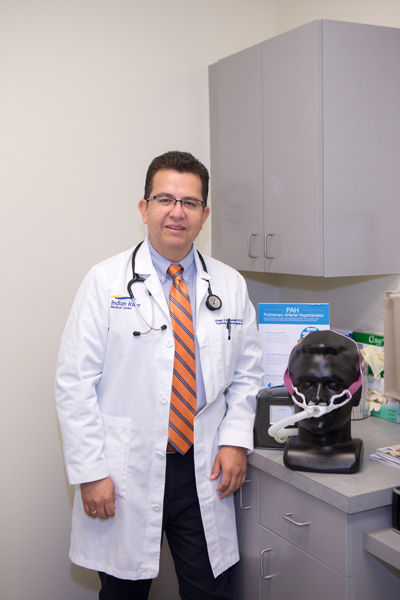Breathe deeply, if you can. If you can’t – and you’re over the age of 45 – you might be staring a life-threatening problem in the face.
According to the American Lung Association, somewhere between 13 and 38 million Americans suffer from “Chronic Obstructive Pulmonary Disease” or COPD and a huge percentage of them don’t even know they have it.
This year alone, nearly 150,000 people in this country will lose their lives to this disease.
In fact, COPD is the third leading cause of death in U.S.
Globally, the disease claims more than three million lives each year. Worse, according to the World Health Organization, “COPD is not curable. Various forms of treatment can help control its symptoms,” but the disease itself cannot be reversed or cured.
Dr. Diego Maldonado, a pulmonary and critical care specialist with Indian River Medical Associates bluntly places the bulk of the blame for COPD on cigarette smoking and adds, “The more you smoke, the more damage you’re going to get.”
Not surprisingly, those who lived through the 1940s, 1950s and 1960s when cigarette smoking was ubiquitous – and companies such as R.J. Reynolds Tobacco actively sought and promoted endorsements from doctors – are particularly at risk for COPD.
So, what exactly is COPD?
The COPD Foundation says, “COPD is an umbrella term used to describe progressive lung diseases including emphysema and chronic bronchitis.”
Maldonado explains that here in Vero Beach he sees more cases of emphysema, saying, “chronic bronchitis is more like the beginning stage of COPD.”
According to the National Institutes of Health, when emphysema takes hold, the walls between the many tiny air sacs inside the lungs have already been damaged beyond repair. As a result, they lose their shape and become “floppy” and the amount of oxygen they can take in – as well as the amount of carbon dioxide they can expel – is radically reduced.
Every part of the human body needs oxygen to survive, so this disease poses multiple threats to multiple parts of cardiovascular, neurological and circulatory systems.
Over time, says NIH, “severe COPD may prevent (patients) from doing even basic activities like walking, cooking or taking care of themselves.”
The American Lung Association echoes Maldonado’s claim about cigarettes. “Smoking is the primary risk factor for COPD,” and adds that, “Approximately 80 percent of COPD deaths are caused by smoking.” Other risk factors can include occupational dust and chemical exposure, air pollution, genetic factors and a history of childhood respiratory infections.
Indeed, infections of any kind pose far greater threats to those who suffer from COPD than to those without the disease.
The flu can cause serious life-threatening problems for people who have COPD, so getting a yearly flu shot is essential. So, also, is getting an annual pneumococcal pneumonia vaccination. Those with COPD are at much higher risk for contracting pneumonia than the public at large.
Maldonado says the COPD is widely under-diagnosed in no small part because until symptoms such as shortness of breath and coughing begin to be noticed, people tend not to seek treatment. Moreover, even when treatment is sought, there is nothing he or any physician can do to reverse the damage already done to the lungs. The best that can be done medically is to preserve whatever lung capacity remains or as Maldonado puts it, “maintain the current quality of life.”
In order to detect COPD, physicians employ a device called a “spirometer” to measure lung function. Specifically, the spirometer measures how efficiently the lungs empty. The results of these tests are used to place patients into one of the four stages of COPD with stage four being the most advanced and dangerous.
While there are a handful of surgical options to treat COPD including lung reduction and lung transplants, Maldonado is quick to point out just how risky those procedures are. For example, while most other organ transplants have about an 80 percent success rate, lung transplants only succeed roughly 60 percent of the time and the risks of infections or the body’s rejection of a new lung are extremely high.
A new, non-surgical technique currently in trials that Maldonado finds promising called “lung reduction through bronchoscopy” is available in parts of Europe but according to Maldonado, it is still probably three to five years away from getting FDA approval in this country.
The good news, if there is any, is that Maldonado sees, “better options to manage the disease” coming onto the market all the time in the form of new medications.
Those medications include “bronchodilators” which relax the muscles around the patient’s airways and make breathing easier. Most are administered with inhalers that go straight to the lungs and can provide between four and 12 hours of relief per dosage.
If the COPD is more advanced, some doctors will prescribe the combination of a bronchodilator and an inhaled steroid. The steroids help reduce airway inflammation but generally most physicians are reluctant to prescribe steroids for extended periods of time because they weaken resistance to infection
Pulmonary rehabilitation is another technique often employed to help save what remaining lung capacity COPD patients have. The rehab may involve physical therapists, respiratory therapists, exercise specialists and dietitians in addition to a pulmonologist like Maldonado along with the patient’s primary care doctor.
In the most severe cases, oxygen therapy may be required complete with oxygen tanks and a mask.
Another shred of good news? U.S. News and World Report’s May 2015 “Best Hospitals for Common Care” survey ranked Indian River Medical Center as a “high performing” hospital for treatment of COPD, well within the top 10 percent of healthcare facilities in the nation.
Dr. Diego Maldonado is with Indian River Medical Associates at 1155 35th Lane, Suite 201 in Vero Beach. The phone number is 772-794-5800.

